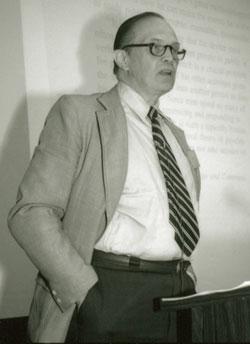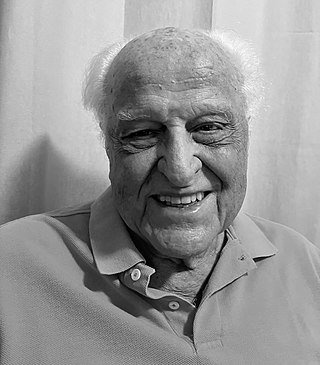Related Research Articles

George Armitage Miller was an American psychologist who was one of the founders of cognitive psychology, and more broadly, of cognitive science. He also contributed to the birth of psycholinguistics. Miller wrote several books and directed the development of WordNet, an online word-linkage database usable by computer programs. He authored the paper, "The Magical Number Seven, Plus or Minus Two," in which he observed that many different experimental findings considered together reveal the presence of an average limit of seven for human short-term memory capacity. This paper is frequently cited by psychologists and in the wider culture. Miller won numerous awards, including the National Medal of Science.

Mathematical psychology is an approach to psychological research that is based on mathematical modeling of perceptual, thought, cognitive and motor processes, and on the establishment of law-like rules that relate quantifiable stimulus characteristics with quantifiable behavior. The mathematical approach is used with the goal of deriving hypotheses that are more exact and thus yield stricter empirical validations. There are five major research areas in mathematical psychology: learning and memory, perception and psychophysics, choice and decision-making, language and thinking, and measurement and scaling.
Robert Goldstone is a Distinguished Professor of psychology and cognitive science at Indiana University in Bloomington, Indiana. His research interests include concept learning and representation, perceptual learning, collective behavior, and computational modeling of human cognition. He has developed and empirically tested neural network models that simultaneously learn new perceptual and conceptual representations, with the learned concepts both affecting and being affected by perception. He has also developed computational models of how groups of people compete for resources, cooperate to solve problems, exchange information and innovations, and form coalitions.
John Robert Anderson is a Canadian-born American psychologist. He is currently professor of Psychology and Computer Science at Carnegie Mellon University.

Michael I. Posner is an American psychologist who is a researcher in the field of attention, and the editor of numerous cognitive and neuroscience compilations. He is emeritus professor of psychology at the University of Oregon, and an adjunct professor at the Weill Medical College in New York. A Review of General Psychology survey, published in 2002, ranked Posner as the 56th most cited psychologist of the 20th century.
William Kaye Estes was an American psychologist. A Review of General Psychology survey, published in 2002, ranked Estes as the 77th most cited psychologist of the 20th century. In order to develop a statistical explanation for the learning phenomena, William Kaye Estes developed the Stimulus Sampling Theory in 1950 which suggested that a stimulus-response association is learned on a single trial; however, the learning process is continuous and consists of the accumulation of distinct stimulus-response pairings.
Bertram Gawronski is a social psychologist and professor of psychology at the University of Texas at Austin. He is known for his research in the areas of attitudes, social cognition, decision making, and moral psychology.
Richard Shiffrin is an American psychologist, professor of cognitive science in the Department of Psychological and Brain Sciences at Indiana University, Bloomington. Shiffrin has contributed a number of theories of attention and memory to the field of psychology. He co-authored the Atkinson–Shiffrin model of memory in 1968 with Richard Atkinson, who was his academic adviser at the time. In 1977, he published a theory of attention with Walter Schneider. With Jeroen G.W. Raaijmakers in 1980, Shiffrin published the Search of Associative Memory (SAM) model, which has served as the standard model of recall for cognitive psychologists well into the 2000s. He extended the SAM model with the Retrieving Effectively From Memory (REM) model in 1997 with Mark Steyvers.

Nora S. Newcombe is the Laura H. Carnell Professor of Psychology and the James H. Glackin Distinguished Faculty Fellow at Temple University. She is a Canadian-American researcher in cognitive development, cognitive psychology and cognitive science, and expert on the development of spatial thinking and reasoning and episodic memory. She was the principal investigator of the Spatial Intelligence and Learning Center (2006-2018), one of six Science of Learning Centers funded by the National Science Foundation.

Some of the research that is conducted in the field of psychology is more "fundamental" than the research conducted in the applied psychological disciplines, and does not necessarily have a direct application. The subdisciplines within psychology that can be thought to reflect a basic-science orientation include biological psychology, cognitive psychology, neuropsychology, and so on. Research in these subdisciplines is characterized by methodological rigor. The concern of psychology as a basic science is in understanding the laws and processes that underlie behavior, cognition, and emotion. Psychology as a basic science provides a foundation for applied psychology. Applied psychology, by contrast, involves the application of psychological principles and theories yielded up by the basic psychological sciences; these applications are aimed at overcoming problems or promoting well-being in areas such as mental and physical health and education.

David LaBerge is a neuropsychologist specializing in the attention process and the role of apical dendrites in cognition and consciousness.
Quantum cognition is an emerging field which applies the mathematical formalism of quantum theory to model cognitive phenomena such as information processing by the human brain, language, decision making, human memory, concepts and conceptual reasoning, human judgment, and perception. The field clearly distinguishes itself from the quantum mind as it is not reliant on the hypothesis that there is something micro-physical quantum-mechanical about the brain. Quantum cognition is based on the quantum-like paradigm or generalized quantum paradigm or quantum structure paradigm that information processing by complex systems such as the brain, taking into account contextual dependence of information and probabilistic reasoning, can be mathematically described in the framework of quantum information and quantum probability theory.
David E. Meyer is an American academic in the field of psychology. He is a professor at the University of Michigan and is Chair of the Cognition and Cognitive Neuroscience area of the Psychology Department. He is director of the University's Brain, Cognition, and Action laboratory.
James Tarlton Townsend is a Distinguished Rudy Professor of Psychology at Indiana University, Bloomington. He is known for his work in mathematical psychology, particularly in distinguishing parallel and serial processing and for models of perception.
Gordon Logan is the Centennial Professor of Psychology at Vanderbilt University. A cognitive and mathematical psychologist, Logan is well known for his work on cognitive control and inhibition of cognitive and motor activity, divided attention and the nature of the human brain’s processing limitations, and the fundamental characterization of attention deficit hyperactivity disorder ADHD. He has also done extensive research on the hierarchical control of skilled copytyping, which he views as a useful model for hierarchically organized complex human skills in general. He collaborates on research that applies mathematical models to neural and behavioral data.
Hal Pashler is Distinguished Professor of Psychology at University of California, San Diego. An experimental psychologist and cognitive scientist, Pashler is best known for his studies of human attentional limitations. and for his work on visual attention He has also developed and tested new methods for enhancing learning and reducing forgetting, focusing on the temporal spacing of learning and retrieval practice.
Robert Mark Nosofsky is a distinguished professor in the department of psychological and brain sciences at Indiana University Bloomington. He is best known for his exemplar theory, which has diverse applications in cognitive science and psychology. His research interest are categorization, recognition memory, math modeling, combining formal modeling and FMRI Studies. His research is in the development and testing of formal mathematical models of perceptual category learning and representation.
F. Gregory Ashby is a Distinguished Professor Emeritus of Psychological & Brain Sciences at the University of California, Santa Barbara (UCSB). He is known for his work in mathematical psychology, cognitive psychology, and cognitive neuroscience.
William D. Timberlake was a psychologist and animal behavior scientist. His work included behavioral economics, contrast effects, spatial cognition, adjunctive behavior, time horizons, and circadian entrainment of feeding and drug use. He is best known for his theoretical work: Behavior Systems Theory and the Disequilibrium Theory of reinforcement.
Thomas L. Griffiths is an Australian academic who is the Henry R. Luce Professor of Information Technology, Consciousness, and Culture at Princeton University. He studies human decision-making and its connection to problem-solving methods in computation. His book with Brian Christian, Algorithms to Live By: The Computer Science of Human Decisions, was named one of the "Best Books of 2016" by MIT Technology Review.
References
- ↑ "Jerome Busemeyer: Department of Psychological and Brain Sciences: Indiana University Bloomington". psych.indiana.edu. Retrieved 2017-02-06.
- ↑ "Cognitive Science at Indiana University".
- ↑ "AFOSR".
- ↑ "Decision".
- ↑ Busemeyer, J. R., & Townsend, J. T. (1993) Decision Field Theory: A dynamic cognition approach to decision making
- ↑ Busemeyer, J., Bruza, P. (2012), Quantum Models of Cognition and Decision, Cambridge University Press, Cambridge.
- ↑ "Jerome Busemeyer - Google Scholar Citations". scholar.google.com. Retrieved 2017-02-06.
- ↑ "Honorary Awards Faculty of Psychology". University of Basel . Retrieved 2020-10-20.